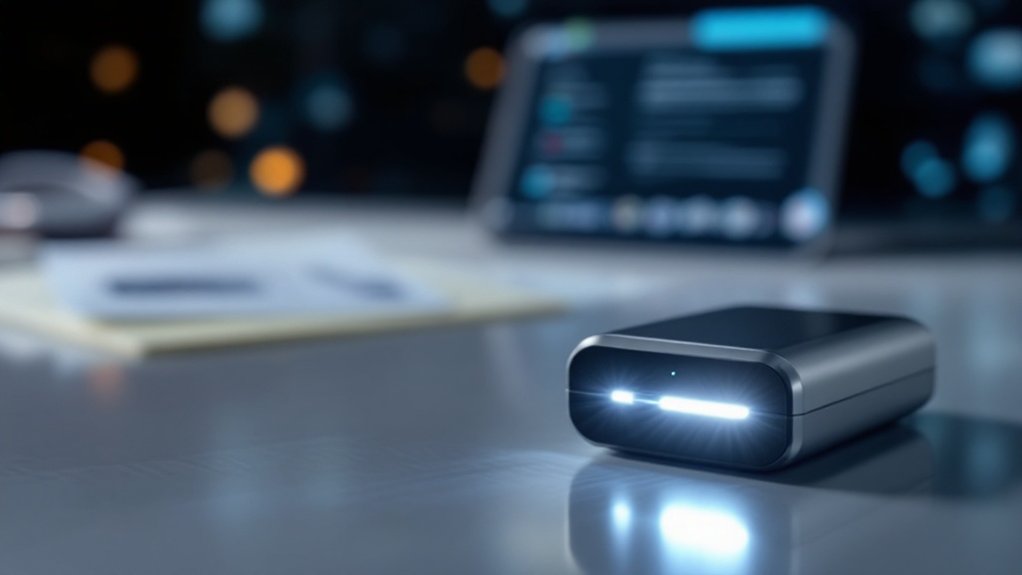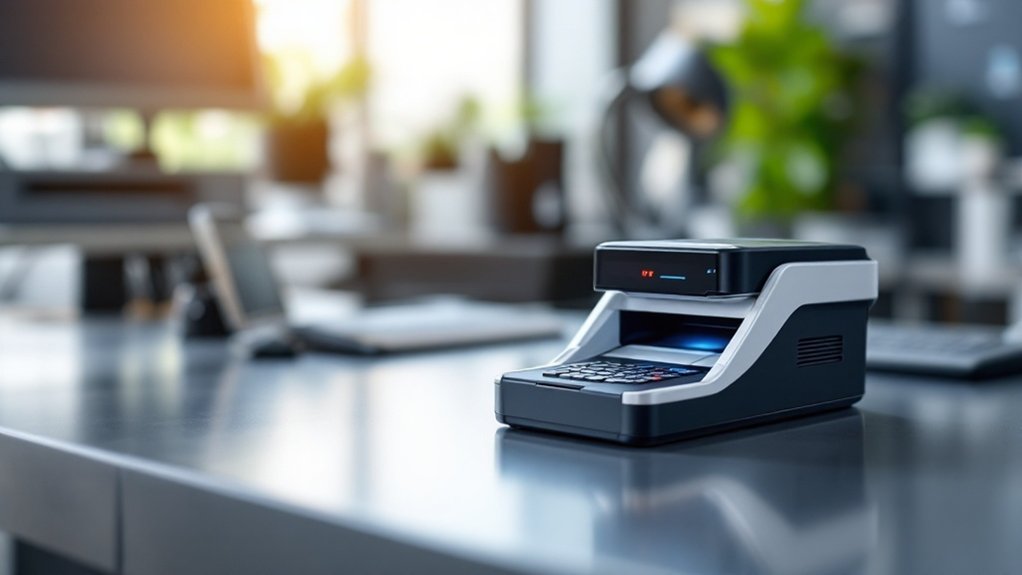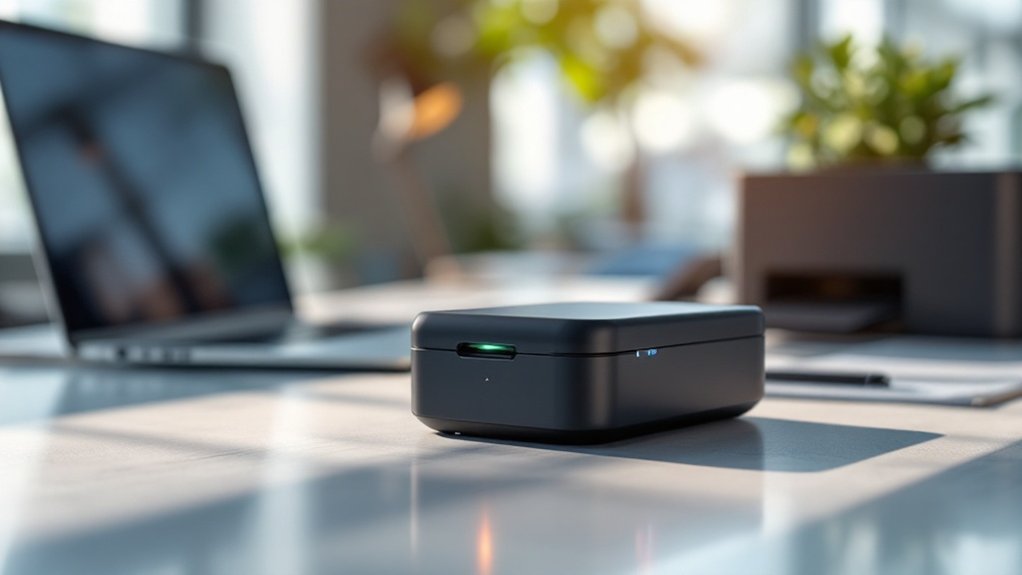When choosing an approved live scan fingerprint scanner, you’ll need to examine several key factors. Guarantee compliance with standards like the FBI’s WSQ for image quality and STQC for specific applications. Also, validate certifications like CE, FCC, and RoHS for safety and environmental compliance. Evaluate the technology, such as LES film or capacitive sensors, and assess vendor experience and reputation. As you explore these options, you’ll uncover more details to help make an informed decision.
Certifications and Compliance

When choosing an approved live scan fingerprint scanner, understanding the various certifications and compliance requirements is indispensable. You should look for certifications like the FBI’s Wavelet Scalar Quantization (WSQ) standard, which guarantees interoperability with FBI systems, and STQC certification, which is pivotal for applications like Aadhaar in India. Additionally, certifications such as CE, FCC, and RoHS are significant for product safety and environmental compliance. Compliance with legal requirements, industry standards like ANSI/NIST, and data privacy laws is also imperative to ensure secure and reliable operations.
Technology and Equipment
When selecting live scan fingerprint scanners, you’ll encounter various types of sensors, including LES film sensors that enhance security through physical contact and capacitive sensors that use electrical impulses to detect fingerprints. Advanced sensors like these offer improved performance and security features, such as liveness detection to prevent spoofing attacks. By understanding these technologies, you can choose scanners that meet your needs for accuracy, reliability, and compliance with regulatory standards. Mobile live scan solutions, which include features like portable equipment, are designed to provide convenience and efficiency in capturing fingerprints on the go.
Scanner Types
Choosing the right live scan fingerprint scanner involves understanding the various technologies and equipment available. You’ll encounter optical scanners, which use light to capture images, capacitive scanners that measure electrical changes, and ultrasonic scanners that utilize sound waves for 3D imaging. Thermal scanners detect temperature differences, while hybrid scanners combine technologies for enhanced security. Each type has its strengths and weaknesses, so it’s essential to select a scanner that meets your specific needs, whether it’s for single finger capture or multi-finger scanning. Additionally, consider features like FBI certification, portability, and data security when making your choice. Live scan systems are particularly beneficial because they support background checks for agencies like the FBI, FINRA, and FDLE, ensuring compliance with regulatory requirements while providing a faster and more accurate process compared to traditional methods.
Advanced Sensors
Advanced sensors play an essential role in live scan fingerprint scanners, enabling them to capture high-quality images even in challenging conditions. Technologies like Light Emitting Sensors (LES) guarantee high image quality, pivotal for accurate fingerprint authentication. Some scanners include Live Finger Detection (LFD) algorithms to prevent fake fingerprints, adding a layer of security.
When choosing a live scan scanner, consider sensors that meet FBI standards for quality and reliability. Look for devices with environmental protection, such as IP ratings, to confirm durability. Additionally, consider the user interface and connectivity options like USB or USB-C for easy integration. Extensive software support is also essential for ensuring image quality and compliance with regulatory standards.
Vendor Experience and Reputation

A vendor’s experience and reputation are pivotal in selecting the right live scan fingerprint scanner provider. You want a vendor with extensive industry knowledge, a proven track record of reliable services across sectors, and adaptability to handle complex processes. Their reputation is essential too; check customer reviews on platforms like Google, Better Business Bureau ratings, and ask for referrals to gauge customer satisfaction and credibility. When evaluating vendors, consider their market presence and feedback from existing clients. A strong reputation often correlates with consistent high-quality services. Guarantee they can provide valuable insights into equipment and software needs, and understand regulatory compliance requirements. This will help you make an informed decision that supports your business’s success. Additionally, ensuring that the vendor’s data is up-to-date and reliable is crucial, as using outdated or unverified information can lead to poor decision-making, especially when it involves critical data.
Operational Efficiency
When you’re evaluating live scan fingerprint scanners, operational efficiency is indispensable for ensuring that your business runs smoothly and effectively. Live Scan technology markedly reduces processing time, providing results in minutes to weeks, compared to traditional methods. It enhances accuracy and reliability by minimizing errors, ensuring precise fingerprint captures. The process is streamlined with automated systems and real-time quality checks, reducing manual labor and increasing efficiency. Efficient data transmission is also pivotal, as it securely sends fingerprint data to systems like AFIS or ABIS. This not only speeds up background checks but also enhances overall operational efficiency by reducing manual handling and potential errors. Additionally, Live Scan’s ability to eliminate the mess and hassle of traditional ink fingerprinting makes it a more efficient choice, especially when using digital fingerprinting processes.
Cost and Value

When choosing approved live scan fingerprint scanners, you need to conduct a price comparison to guarantee you’re getting the best value for your investment. This involves weighing the cost of equipment, such as models from Thales and Suprema, against the benefits of advanced features and support. By analyzing the return on investment, you can determine whether the higher upfront costs of premium scanners will pay off through increased efficiency and customer satisfaction. Additionally, understanding that the Thales DactyScan84c starts at around $6,800, which is considered a budget-friendly option with software included, can help in making informed purchasing decisions.
Price Comparison
How much you’re willing to spend on a live scan fingerprint scanner can substantially influence your choice. Live scan systems typically range from $6,800 to $12,000, including hardware and software. Models like the Thales DactyScan84c start around $6,800, while more budget-friendly options, such as the Mantra MORPHS 10-Print Fingerprint Scanner, cost $699. High-end models like the Thales Cogent Palm Scanner CS500q are priced at $6,500. When comparing prices, consider the total cost of ownership, including ongoing maintenance and software updates. This will help you make an informed decision that aligns with your budget and operational needs. Additionally, choosing a live scan system that offers accurate results is crucial, as it ensures that the fingerprint images captured are of high quality, reducing the need for retakes and improving overall efficiency.
Return on Investment
Evaluating the return on investment (ROI) for live scan fingerprint scanners involves a detailed analysis of both costs and value. Your initial investment typically ranges from $4,000 to $6,000, which can be recouped quickly if you perform a high volume of scans. The demand for your services and competitive pricing strategies are vital for profitability. Efficient operations and customer retention also play significant roles in maximizing ROI.
To achieve a strong ROI, focus on delivering high-quality services that build customer trust and loyalty. This not only enhances your reputation but also guarantees long-term growth potential by adapting to technological advancements and compliance updates.
Mobility and Flexibility**
Choosing an approved live scan fingerprint scanner requires careful consideration of its mobility and flexibility. You need a device that can operate effectively in various environments. For instance, compact scanners like the Integrated Biometrics Kojak are ideal for mobile setups due to their lightweight design.
When evaluating scanners, consider these key factors:
- Portability: Tablet-based devices offer flexibility in different settings.
- Communication Methods: Wi-Fi, Bluetooth, and cellular capabilities enhance connectivity.
- Environmental Adaptability: Devices that operate well in direct sunlight are beneficial.
- Multi-Modal Biometrics: Systems supporting multiple biometric types increase versatility.
Additionally, devices like the Suprema RealScan G10, which offer advanced capabilities for both office and mobile setups, are highly recommended for comprehensive fingerprinting solutions.
Conclusion
Choosing the right live scan fingerprinting device is like finding a key to a secure vault—each element must fit perfectly. Guarantee your scanner has certifications like FBI Appendix F and compliance with industry standards. Select advanced technology and dependable vendors with a solid reputation. Consider operational efficiency, cost-effectiveness, and mobility. By doing so, you’ll access a seamless and secure fingerprinting process that enhances your business operations.

